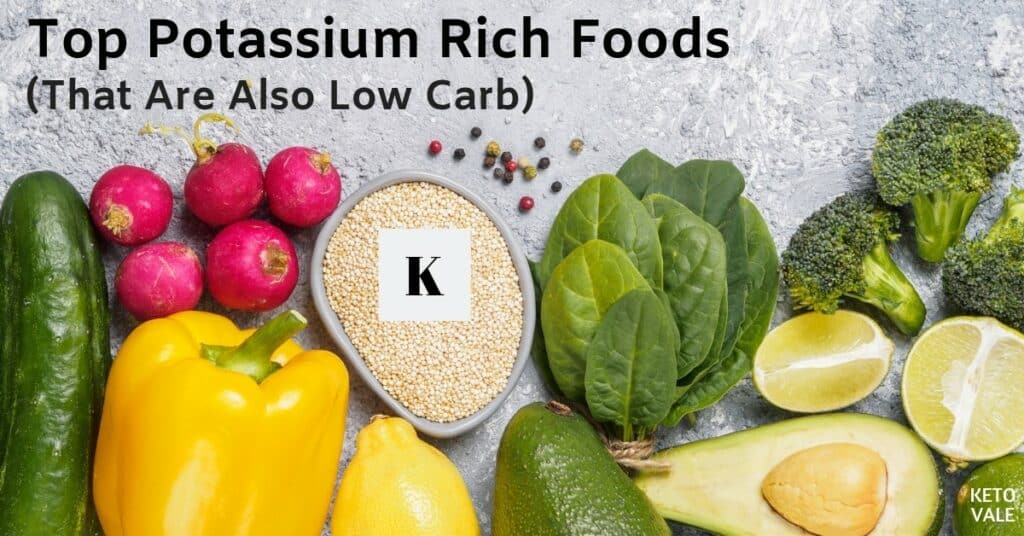Potassium is an essential micronutrient for your health, and one of the minerals you need the most of – almost 5 grams daily.
We’ve previously covered the importance of potassium for the normal functioning of your body.
A great number of people are deficient in it, which can provoke a number of problems, and if you’re doing keto or low carb diet, you need to be particularly strict with your potassium consumption, as it’s flushed from your body at a higher rate than usual.
Potassium is not readily stored in the body (as is, for example, sodium), so you need to make sure you’re meeting your requirements on a daily basis.
Having a diet rich in whole and natural foods is the best way to achieve that. Most tracking apps will also track potassium, so that’s an excellent (and easy) way to keep an eye on it.
Let’s now see what the best sources of potassium are, especially if you’re following a low-carb or a ketogenic diet.
Yes, many fruits including bananas and underground veggies such as potatoes are off-limits, although they do have a solid amount of potassium in them.
However, there are plenty of other awesome options to choose from besides bananas, such as:
#1. Spinach
Spinach and other leafy greens are one of the best choices out there if you want to make sure you’re getting enough potassium from your food.
A 100 g (3.5 oz) serving of it contain 558 mg potassium, which is truly impressive (1).
To meet half of your daily potassium needs, you need a bit more than 400 g (14 oz) of spinach, which will only set you back with 5.6 g net carbs (yes – for the whole 400 g of it!)
It’s one of the most widely available vegetables across the world, so you’ll probably be able to find it year-round.
Alternatively, you can always use frozen or canned spinach, for the same nutritional value. Frozen spinach also makes an excellent smoothie ingredient.
A word of caution – spinach is high in oxalates, so for those of you prone to kidney stones, it might be best not to consume it daily. You can still have spinach – just in moderation.
Potassium in 100 g (3.5 oz) raw spinach: 558mg
Net carbs and calories in 100 g (3.5 oz): 1.4 g net carbs / 23 kcal
Other leafy greens that are high in potassium include beet greens (the leaves of beetroot), Swiss chard, mustard spinach, kale, and bok choy.
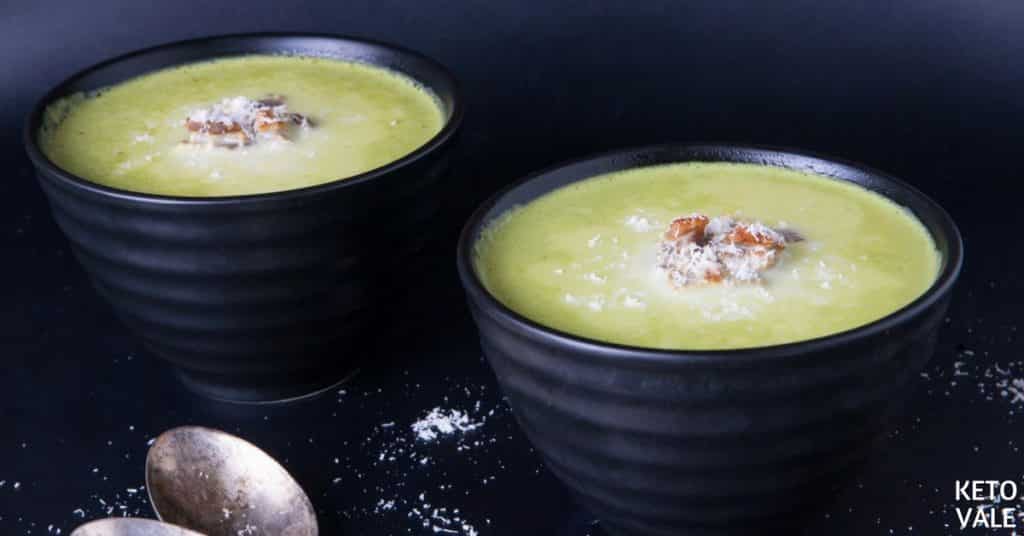
Suggested recipes:
- Creamy Spinach Soup With Crispy Bacon
- Keto Strawberry Brazil Nuts Spinach Smoothie
- Keto Chocolate Raspberry Spinach Green Smoothie
#2. Avocado
Avocados are awesome for plenty of reasons. They’re low-carb while being very nutrient-dense, and pack a good amount of healthy fats in them. You can make many keto dishes with avocado.
A 100 g (3.5 ounces) serving of avocados contain 15 g fat. As for their potassium content, it’s equally remarkable: 485 mg for the same serving size (2).
Their fiber content is 7g per 100g which makes them an excellent choice, if you’re struggling with constipation (a somewhat common side effect of keto for the first few weeks).
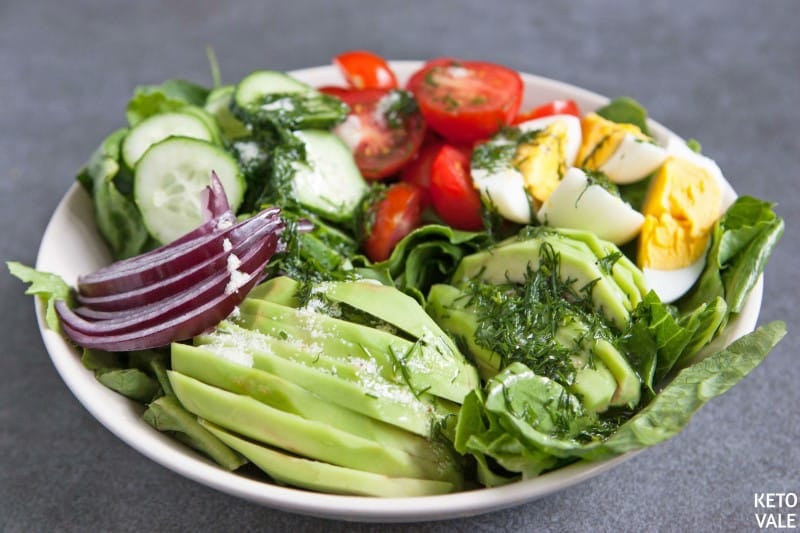
On top of that, avocados are a good source of vitamin K and folate, important for bone health and production of red blood cells (3).
Potassium in 100 g (3.5 oz): 485mg
Net carbs and calories in 100 g (3.5 oz): 1.8 g net carbs / 160 kcal
Related: Top 14 Low-Carb High-Fiber Foods
#3. Salmon (and fish in general)
Salmon, especially wild-caught, is very health. It’s high in omega 3 fatty acids, which are super important for the health of your brain, cardiovascular system, and eyes.
Additionally, it contains a lot of essential micronutrients, such as phosphorus, selenium, vitamins B6 and B12, plus potassium.
Half a fillet of wild salmon (around 200 g, or 7 oz) will give you 970 mg of potassium, while for farm-raised the amount would be 719 mg (4, 5).
Salmon is rich in both protein and in healthy fats, making it an excellent choice for keto.
Wild-caught Atlantic salmon (raw):
- Potassium in 100 g (3.5 oz): 490 mg
- Net carbs and calories in 100 g (3.5 oz): 0 g net carbs / 142 kcal
Farmed Atlantic salmon (raw):
- Potassium in 100 g (3.5 oz): 363 mg
- Net carbs and calories in 100 g (3.5 oz): 0 g net carbs / 208 kcal
Some other fish also contains a solid amount of potassium, such as tuna, trout, halibut, and cod.
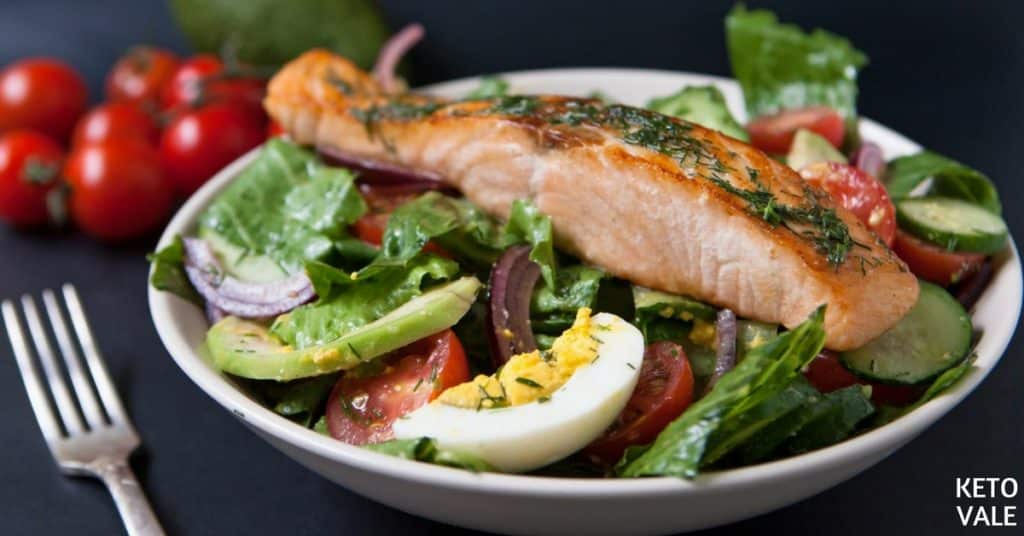
Suggested recipes:
#4. Clams
If you live near the coast, consider yourself lucky. Clams are an excellent food to add to anyone’s diet.
If not, you can still probably find them in bigger supermarkets, or grab a can of clams for convenience.
They are packed with important nutrients, such as iron, phosphorus, zinc, manganese, selenium, vitamins A, C, B12 and an impressive amount of potassium of 628 mg per 100 g (3.5 oz) of cooked clams (6).
Similarly to mussels, they’re slightly higher in carbs, approximately 5.1 g net carbs per 100 g of clams.
Nevertheless, even if you’re following a strict keto diet, you could still fit some clams in your menu.
You just need to plan accordingly and keep your carbs from other foods for that day lower.
Potassium in 100 g (3.5 oz) cooked clams: 628 mg
Net carbs and calories in 100 g (3.5 oz): 5.1 g net carbs / 148 kcal
#5. Mushrooms
Mushrooms make an excellent side dish, or can also be added to omelettes, frittatas, soups, or all kinds of other dishes.
They contain a host of essential minerals and vitamins, such as phosphorus, copper, selenium, niacin, and riboflavin, plus a very good amount of potassium.
A 100 g (3.5 oz) serving of raw white mushrooms comes with 318 mg of it (7).
A quick and simple way to prepare mushrooms is to stir-fry or sauté them in butter. You can use this simple 2-ingredient recipe to meal prep.
It’s easily scalable, stores well in the fridge (for 3 to 5 days), and you can combine it with almost any protein source out there.
If you like mushrooms, they come in many varieties such as shiitake, button mushrooms, oyster, crimini, to name just a few, so you definitely won’t get bored.
Potassium in 100 g (3.5 oz) white mushrooms (raw): 318 mg
Net carbs and calories in 100 g (3.5 oz): 2.3 g net carbs / 22 kcal
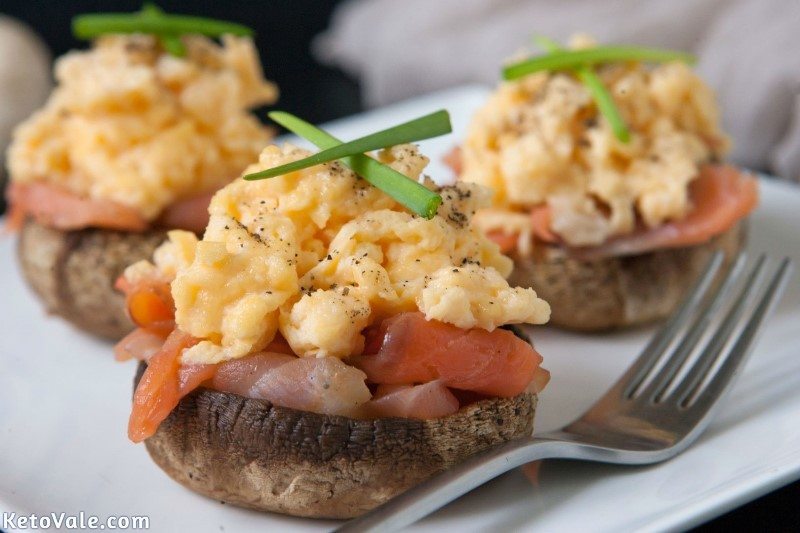
Suggested recipes:
- Mozzarella Stuffed Turkey Meatballs with Creamy Mustard Mushroom Sauce
- Smoked Salmon Egg Stuffed Mushroom
- Baked Chicken Thighs with Bacon Mushroom Sauce
#6. Tomatoes
In a salad, in a dish, as a standalone snack, tomatoes (cherry and regular, black and red, and all other varieties) are an awesome food, and they come with a good amount of potassium in them.
They’re slightly higher in carbs. A 100 g (3.5 oz) serving stands at 2.7 g net carbs, so you need to make sure you’re properly tracking them, but at the same time they’re super low in calories. The same serving size contains only 18 calories (8).
Cherry tomatoes, when they’re in season, can be very sweet, so you could even use them to satisfy a sweet tooth.
Potassium content per 100 g / 3.5 oz: 237 mg
Net carbs and calories for 100 g / 3.5 oz: 2.7 g net carbs / 18 calories
Suggested recipes:
- Baked Pesto Shrimp with Cauliflower and Tomatoes
- Keto Zucchini Cherry Tomatoes Frittata
- Arugula Salad with Parmesan and Cherry Tomatoes
#7. Broccoli
Broccoli is kind of higher in carbs, compared to other low-carb veggies, but you can definitely have some from time to time, as it’s very rich in essential micronutrients, such as vitamins C, K and B9, manganese, phosphorus, and, of course, potassium.
It can be stored for up to two weeks if you tightly wrap it in a plastic bag, but its nutritional value degrades with time, so it’s best to eat it when it’s fresh.
In the Northern hemisphere it’s in season in the colder part of the year (October – April), but usually, you can find it year round.
Another alternative is frozen broccoli. Freezing is actually an excellent way to preserve nutrients.
When cooking broccoli, it’s very easy to overdo it, since it’s so tender. Usually, a couple of minutes of boiling or steaming are completely sufficient.
If you’re boiling it, remove it from the boiling water once it’s ready. Simply turning off the heat will result in overcooking it.
Potassium in 100 g (3.5 oz) raw broccoli: 316 mg (9)
Net carbs and calories in 100 g (3.5 oz): 4 g net carbs / 34 kcal
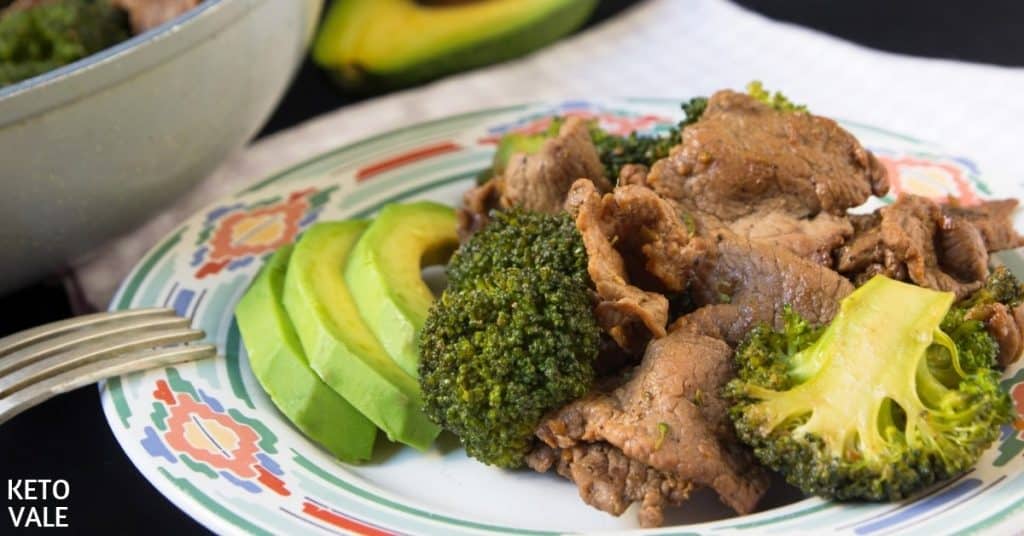
Suggested recipes:
- Keto Beef and Broccoli Stir Fry
- Keto Teriyaki Chicken Thighs with Broccoli
- Garlic Butter Chicken Breast with Steamed Broccoli
#8. Cauliflower
If you’re looking for a low-carb alternative to rice, cauliflower is your friend.
Cooked cauliflower only has 2.1 g net carbs per 100 g, compared to nearly 28 g net carbs for the same quantity of cooked rice. On top of that, cauliflower is very nutrient-rich.
Similar to broccoli, it contains lots of vitamins C K, B6, and B9, plus antioxidants and, of course, different minerals including phosphorus, manganese, and a solid amount of potassium. A cup of raw cauliflower (100 g or 3.5 oz) comes with 303 mg of it (10).
Potassium in 100 g (3.5 oz) raw cauliflower: 303 mg
Net carbs and calories in 100 g (3.5 oz): 2.8 g net carbs / 25 kcal
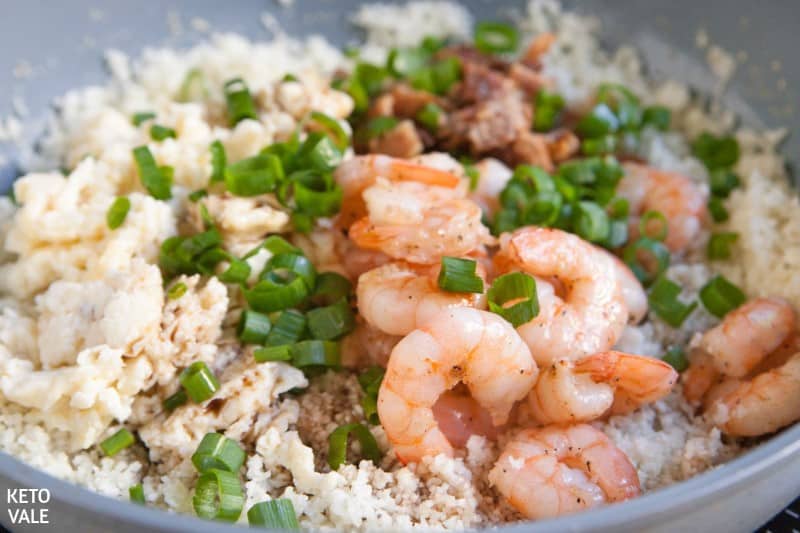
Suggested recipes:
- Keto Shrimp Cauliflower Fried Rice
- Keto Chicken Cauliflower Fried Rice
- Keto Cauliflower Grilled Cheese Sandwiches
#9. Meat (beef, pork, chicken)
Meat is one of the staples of both low-carb and ketogenic diets unless you’re vegetarian or vegan as it has practically 0 carbs (with the exception of some offal), and is a prime protein source that can be as fatty or as lean as you like.
Thankfully, meat is also very rich in potassium. The exact amount varies between the different types of meat but generally sits between approximately 200 mg (such as in 100 g bacon, or in 100 g chicken leg with skin) and 325-360 mg (325 mg for ground beef that is 10% fat, and 360 mg for 100 g pork loin).
#10. Asparagus
Asparagus definitely deserves its place in a low-carb diet.
It has only 1.9 g net carbs and 20 kcal per 100 g (3.5 oz). It’s rich in potassium, as well as in dietary fiber and a number of antioxidants, such as different flavonoids and vitamin E and C.
Storing it is a bit tricky, as it only stays fresh for about 2-3 days. For best results, you can cover both ends in a moist cloth and put it in a plastic bag in the fridge.
There are plenty of ways to prepare asparagus. You can steam it, boil it, bake it, stir-fry it or even just microwave it, which is arguably the simplest method.
To do that, you simply need to microwave it with 30-40 ml of water for 6 minutes in total, stirring it once or twice in the middle.
Potassium in 100 g (3.5 oz) raw asparagus: 202 mg (11)
Net carbs and calories in 100 g (3.5 oz): 1.9 g net carbs / 20 kcal
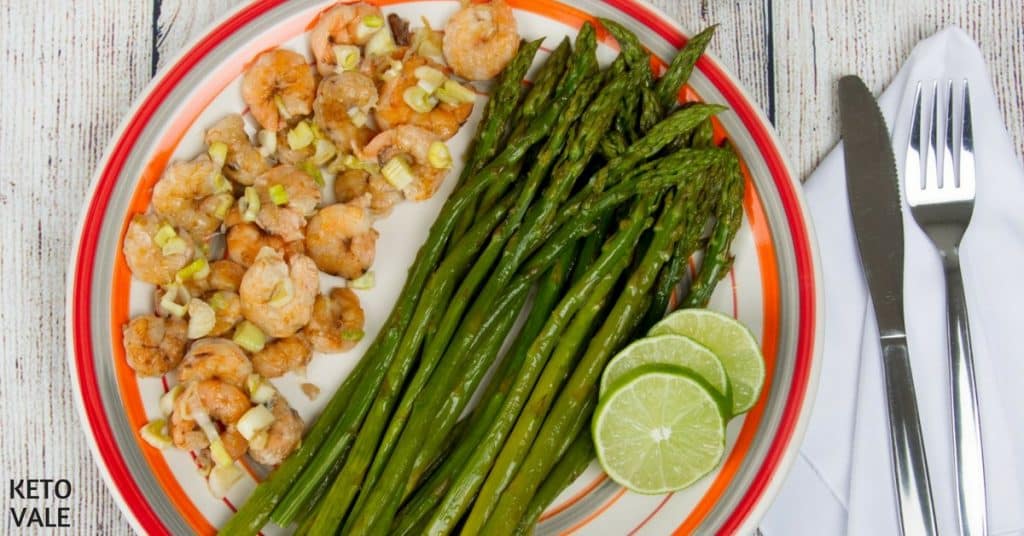
Suggested recipes:
- Roasted Lemon Butter Garlic Shrimp and Asparagus
- Bacon Wrapped Asparagus
- Eggs and Asparagus Breakfast Bites
#11. Zucchini
Zucchini is super versatile and you could use them for plenty of different low-carb recipes. You could even make zoodles – an awesome spaghetti substitute if you’re craving pasta.
They are packed with nutrients, including potassium – 262 mg per 100 g – while still being quite low in carbs (2.2 g net carbs per 100 g / 3.5 oz) (12).
Did you know that zucchini can be eaten raw, too? Although not many people eat them this way, it’s perfectly safe to do that as long as you wash them well. Raw they’re super crunchy and very tasty, and you could add them to salads or eat them with dips.
Potassium in 100 g (3.5 oz) raw zucchini: 262 mg
Net carbs and calories in 100 g (3.5 oz): 2.2 g net carbs / 16 kcal
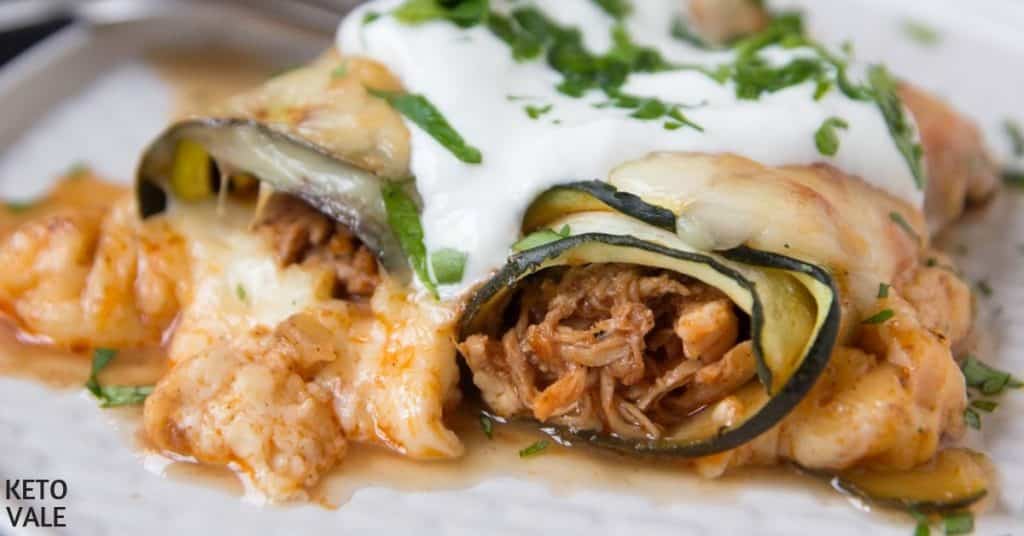
Suggested recipes:
- Keto Zucchini Chicken Enchiladas
- Cheesy Steak Zucchini Boats
- Creamy Shrimp Alfredo with Zucchini Noodles
#12. Eggplant
Eggplant’s delicious, creamy texture makes it an excellent ingredient for dips and sauces, and it tastes great when grilled or sautéed.
Spare yourself the effort and don’t peel it, unless it’s a very big one and therefore older and with a rougher skin. It’s best to choose smaller eggplants anyway, as their taste is richer and less bitter.
Eggplant is a good source of potassium and dietary fiber, which makes it particularly good for a low carb or a ketogenic diet.
Potassium in 100 g (3.5 oz) raw eggplant: 230 mg (13)
Net carbs and calories in 100 g (3.5 oz): 2.3 g net carbs / 24 kcal
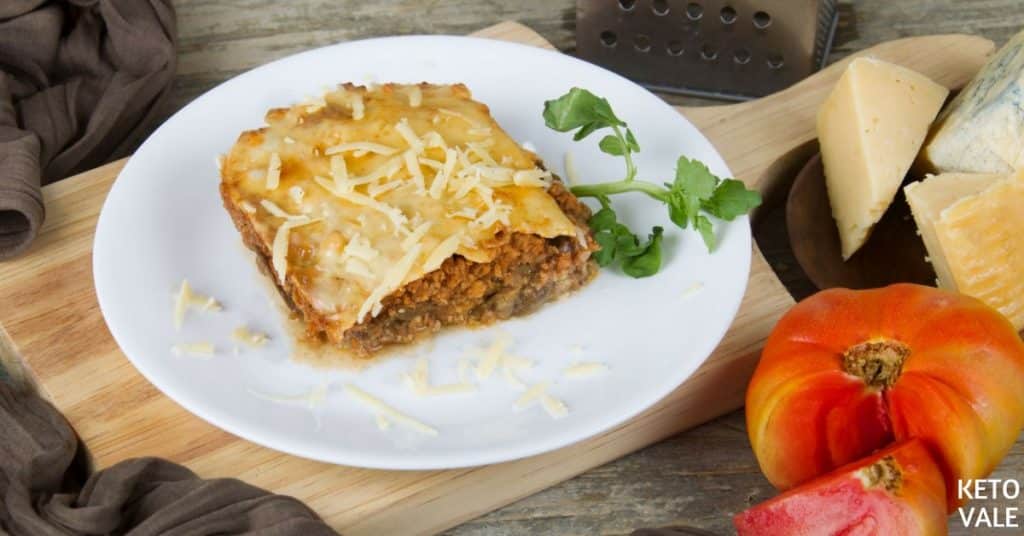
Suggested recipes:
- Keto Classic Greek Moussaka with Eggplant and Chicken
- Baked Stuffed Eggplant with Cheese and Tomato
- Keto Beef and Eggplant Lasagna
#13. Cucumbers
Cucumbers are a low-carb, low-calorie food that is excellent for a quick snack, especially if you need something crunchy. Plus, potassium!
They’re very easy to add to your diet and add lots of volume for a very small amount of calories, so if your goal is weight loss, slice some cucumbers as a side, or add them to your salad.
Peeled cucumber is slightly lower in carbs. There is 1.5 g net carbs for 100 g (3.5 oz) peeled cucumber vs. 3.1 g net carbs for the same amount if you keep the peel on, while the loss of potassium is minimal. So if you’re doing strict keto, peeling your cucumbers is your best bet (14, 15).
Potassium in 100 g (3.5 oz) peeled cucumber: 136 mg
Net carbs and calories in 100 g (3.5 oz): 1.5 g net carbs / 12 kcal
#14. Yogurt (Unsweetened)
Yogurt is kind of high in carbs. It has 3.6 g per 100 g (3.5 oz), but you can still fit some of it in your daily macros, and it makes an excellent base for dessert.
It contains a good amount of probiotics, which means it boosts your gut health and improves digestion, and also improves your immunity (16).
For example, you can add a few frozen raspberries or a handful of blueberries, and a keto-friendly sweetener, if needed. Unsweetened cocoa powder is another way to soothe your chocolate cravings.
Just make sure the yogurt you’re buying is unsweetened because the sugar contained in sweetened yogurts is not healthy and will blow your macros.
Potassium in 100 g (3.5 oz) regular yogurt: 155 mg (17)
Net carbs and calories in 100 g (3.5 oz): 3.6 g net carbs / 59 kcal
#15. Black Tea (Unsweetened)
This might come off as a surprise, but black tea actually contains potassium.
Although the amount in a single cup is somewhat modest – it’s only about 88 mg. But if you drink a few cups a day, it definitely adds up.
Green and oolong tea don’t contain as much potassium as black tea, but they’re healthy for other reasons.
If you plan on drinking black tea to boost your potassium consumption, make sure to drink it plain, without sugar or milk in it because both of these ingredients aren’t keto-friendly at all.
If you need to sweeten it, you could use a sweetener that’s keto-approved, and you could also add a splash of heavy cream (or half-half) if you’re missing the milk.
Make sure you weigh and track cream, as it’s high in calories and even small amounts of it can quickly add up.
Homemade tea is best, and you could even make ice tea at home. Most store-bought brands contain sugar, so make sure to check the label before buying it. Plain tea should be 0 calories.
If you’re ordering tea from Starbucks (or elsewhere), ask for an unsweetened version.
Potassium in a cup of black tea: 88 mg (18)
Our Conclusion
If you’re struggling with your electrolyte intake, there are plenty of excellent low-carb options to choose from, which will help you boost it naturally. Potassium supplements aren’t generally recommended – getting enough of that particular electrolyte from food is your best bet.
Tracking it to make sure you’re hitting the daily requirements of potassium (4700 mg for adults) is especially important if you’re doing keto, and most tracking apps do that automatically, so just check yours to make sure it does.
If you’re deficient in potassium, you might experience some nasty symptoms such as tiredness, muscle fatigue or cramps, constipation, palpitations, and more. So, if in doubt, reach out for some spinach or avocado – or one of the other 15 low-carb foods listed above – to see if that helps.
Up Next: Top 10 Magnesium-Rich Foods That Are Low Carb
Enjoy this post? Share to save for later!
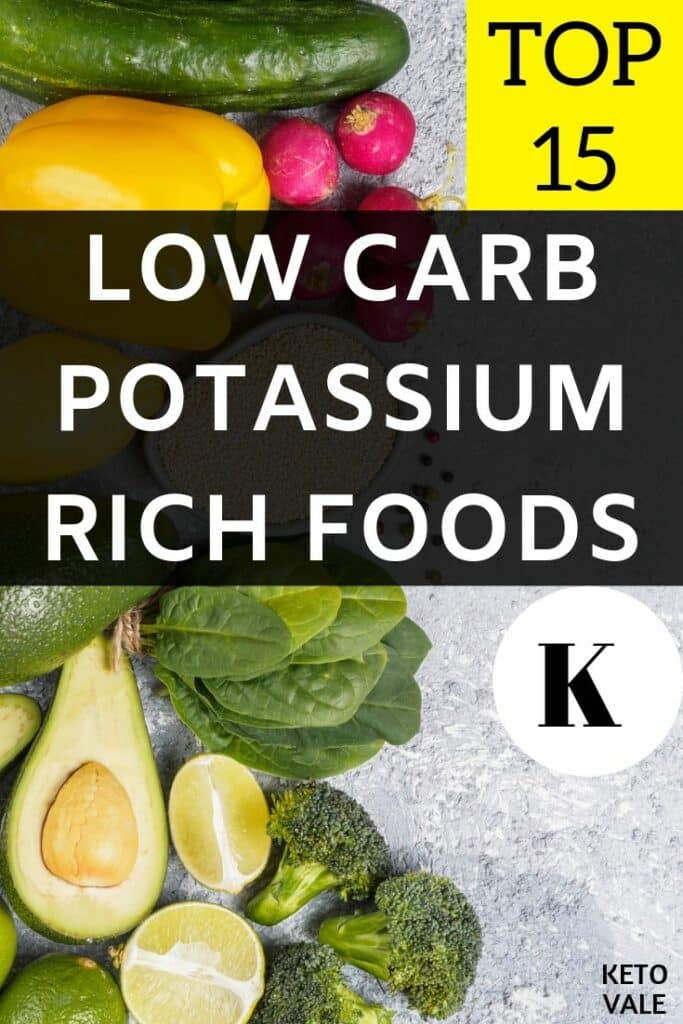
Photos credit: Fascinadora/Depositphotos.com
